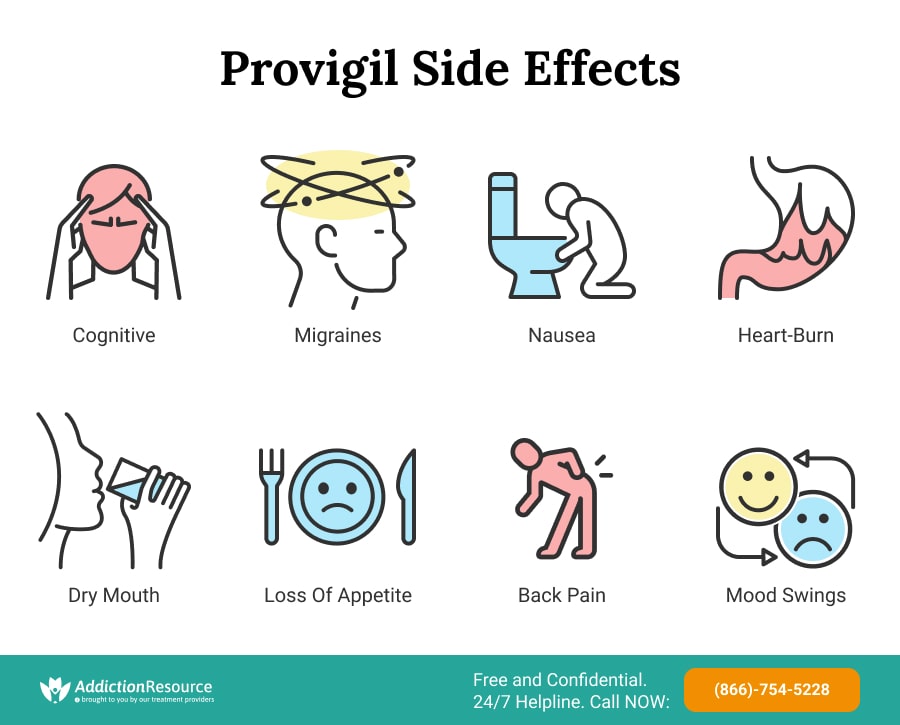
Falling asleep during critical tasks may lead to severe injuries and accidents. Drowsy driving may be responsible for around 21% of all collisions in the U.S. alone. For health conditions like narcolepsy, shift work disorder, and obstructive sleep apnea, finding a solution to stay fully awake and healthy is crucial for optimal performance.
Provigil (modafinil) is a drug used to treat excessive sleepiness associated with these conditions. Due to its rise in popularity among healthy individuals seeking to fight fatigue, it’s important to explore Provigil’s side effects and potential health complications associated with its use.
Read on to learn more about how modafinil interacts with your body.
Table Of Contents:
Provigil Overview
Provigil, known generically as modafinil, is a prescription-only non-amphetamine central nervous system (CNS) stimulant primarily used to promote wakefulness in people suffering from excessive daytime sleepiness. By stimulating the CNS, modafinil helps patients stay awake and alert during the day.
The FDA-approved uses of Provigil include:
- Narcolepsy
- Shift work sleep disorder
- Obstructive sleep apnea
The off-label uses of Provigil include:
- Attention-deficit hyperactivity disorder in children
- Multiple sclerosis-related fatigue
- Acute unipolar and bipolar depressive episodes
Modafinil Side Effects
Modafinil is usually a well-tolerated stimulant. The most frequently reported side effects of modafinil affect less than 10% of its users.
During the treatment, you may experience the following side effects:
-
Headache
Headaches are one of the most frequently reported side effects of Provigil. In a study, this side effect was noted to be dose-related, with a higher incidence at higher doses of the medication (300 mg or 400 mg).
If you are experiencing headaches during Provigil treatment, you can try:
- Over-the-counter pain relievers such as ibuprofen (Advil) or acetaminophen (Tylenol).
- Staying hydrated and ensuring adequate rest.
- Add physical exercise to your daily routine for stress relief.
- Consult your healthcare provider to adjust the dosage or recommend alternative treatments.
If headaches persist or worsen, talk to your doctor to rule out other underlying issues.
-
Loss of Appetite
If you have noticed some modafinil weight loss before and after starting the medication, you may have wondered: Does modafinil cause weight loss?
Probably. Although only a few studies have directly assessed modafinil’s effects on food intake, several have documented decreased appetite as a common side effect. It can result in a decreased desire to eat, leading to reduced caloric intake and potential weight loss over time.
If you don’t want to lose weight or feel low in energy, you can:
- Eat nutrient-dense foods that provide essential vitamins, minerals and calories in smaller portions.
- Instead of three large meals, try eating smaller, more frequent meals throughout the day.
- Focus on eating foods that you find particularly appetizing and enjoyable.
- Establish a regular eating schedule to help normalize your appetite.
Given the modafinil appetite suppression effect, there is growing interest in exploring modafinil’s potential for treating obesity. Yet, modafinil for weight loss is still being researched.
-
Nausea
Nausea is another of the most frequently reported side effects of Provigil. Patients may experience a queasy or unsettled stomach, which can sometimes be accompanied by vomiting. This discomfort can occur shortly after taking the medication and may vary in severity.
For feeling less nauseous, you can:
- Drink water throughout the day to help settle your stomach.
- Smaller and more frequent meals prevent you from feeling too full and reduce nausea.
- Try ginger tea, ginger ale (with natural ginger), or peppermint tea to help alleviate nausea.
- Consider OTC medications like Bismuth subsalicylate (Pepto-Bismol) to reduce nausea symptoms.
After starting modafinil treatment, waiting for your body to adapt to the medication is a good tip. Nausea from modafinil typically improves or resolves completely as your body adjusts. If nausea persists or significantly impacts your daily life, speak to your doctor.
-
Heart Problems
While not common, modafinil can markedly affect autonomic cardiovascular regulation, increasing heart rate and blood pressure.
Users may experience palpitations, increased heart rate, and high blood pressure. These changes, though typically not severe, require caution, particularly in patients with cardiovascular disease. To manage potential cardiovascular issues, you can:
- Regularly check your heart rate and blood pressure.
- Avoid other stimulants such as caffeine and nicotine.
- Engaging in stress-reducing activities such as yoga or meditation.
- Add heart-pumping exercise to your daily routine.
If you have a preexisting cardiovascular condition, discuss it with your healthcare provider before starting Provigil. Immediately report any new or worsening symptoms, including persistent palpitations, significant increases in heart rate, or high blood pressure.
-
Skin Reactions
Skin reactions are rare but serious side effects associated with modafinil. These reactions can include conditions like Stevens-Johnson syndrome (SJS) and fixed drug eruption (FDE).
Symptoms of severe skin reactions can include a widespread rash, blisters, peeling skin and sores on the mucous membranes (such as the mouth, eyes, and genitals), recurrence of a rash at the same site on the skin or mucous membrane with repeated modafinil use.
To avoid this adverse severe effect:
- Be vigilant for new or unusual skin symptoms, such as rashes, blisters or sores for early detection.
- If you develop a skin rash or other skin reaction after starting Provigil, discontinue use immediately.
- Contact your doctor or go to the emergency room.
Once a severe skin reaction has been associated with modafinil, avoid re-exposure to the drug to prevent recurrence and ensure it is documented in your medical records.
Other Modafinil Side Effects
In addition to the mentioned side effects, modafinil (Provigil) can cause various other side effects. These can range from mild to severe and may affect different systems in the body.
Here is a list of other potential side effects associated with modafinil:
- Insomnia
- Nervousness or anxiety
- Dizziness
- Dry mouth
- Diarrhea
- Infections
- Depression
- Back pain
- Mood swings
- Confusion
- Constipation
- Tremors
- Spastic muscles and difficulty in movements
- Epistaxis/nose bleeding
Modafinil Dependence and Misuse
Modafinil can induce euphoria and mood changes due to its effect on brain chemicals like dopamine, potentially leading to misuse and dependence, especially among those with a past substance use disorder. Misuse includes taking it in higher or more frequent doses or for non-medical reasons, increasing dependence risk.
Always take modafinil exactly as prescribed by your doctor. Only after consulting your provider can you adjust the dosage or frequency.
Provigil Side Effects – Bottom Line
Provigil (modafinil) is a powerful medication used to promote wakefulness and manage conditions like narcolepsy, shift work disorder, and obstructive sleep apnea. While it can be highly effective, you must always be cautious about its potential side effects.
Understanding and managing these side effects can help you benefit from the medication while minimizing adverse outcomes. If you experience severe side effects, don’t hesitate to call your doctor.
If you or someone you know struggles with substance use, call SAMHSA’s National Helpline at 1-800-662-4357 for confidential and free assistance 24/7 or find a local rehab center for treatment and recovery services.
People Also Ask
Does modafinil cause weight gain?
Modafinil generally does not cause weight gain. It often decreases appetite, potentially leading to Provigil weight loss rather than weight gain.
Does cause water retention?
Modafinil is not associated with water retention. Most side effects relate to the central nervous system and cardiovascular system.
Does modafinil cause hair loss?
Hair loss is not a commonly reported side effect of modafinil. Most adverse effects involve headaches, nausea and insomnia.

Hope Without Commitment
Find the best treatment options. Call our free and confidential helpline
Most private insurances accepted
Find Drug Rehabilitation Centers Near You Anywhere In the US
Addiction Resource team has compiled an extensive list of the top drug rehabilitation facilities around the country. Use our locator tool to find the best centers near you.
Page Sources
- Atherton, A. (2023, November 6). Drowsy Driving Is a Factor in 21% of Fatal Crashes. Why Don’t We Talk About It More? Sleep Foundation.
- Greenblatt, K., & Adams, N. (2023, February 6). Modafinil. StatPearls - NCBI Bookshelf.
- Teodorini, R. D., Rycroft, N., & Smith-Spark, J. H. (2020). The off-prescription use of modafinil: An online survey of perceived risks and benefits. PLOS ONE, 15(2), e0227818.
- Roth, T., et al. (2007). Evaluation of the Safety of Modafinil for Treatment of Excessive Sleepiness. Journal of Clinical Sleep Medicine : JCSM : Official Publication of the American Academy of Sleep Medicine, 3(6), 595-602.
- Perez, G. A., et al. (2008). Modafinil decreases food intake in humans subjected to simulated shift work. Pharmacology, Biochemistry, and Behavior, 90(4), 717.
- Taneja, I., et al. (2005). Modafinil elicits sympathomedullary activation. Hypertension, 45(4), 612–618.
- Holfinger, S., Roy, A., & Schmidt, M. Stevens-Johnson Syndrome After Armodafinil Use. Journal of Clinical Sleep Medicine : JCSM : Official Publication of the American Academy of Sleep Medicine, 14(5), 885-887.
- Ghoshal, L., & Sinha, M. (2015). Fixed drug eruptions with modafinil. Indian Journal of Pharmacology, 47(2), 224-226.


 Reviewed by:
Reviewed by:  Written by:
Written by: 

 FindTreatment.gov
FindTreatment.gov